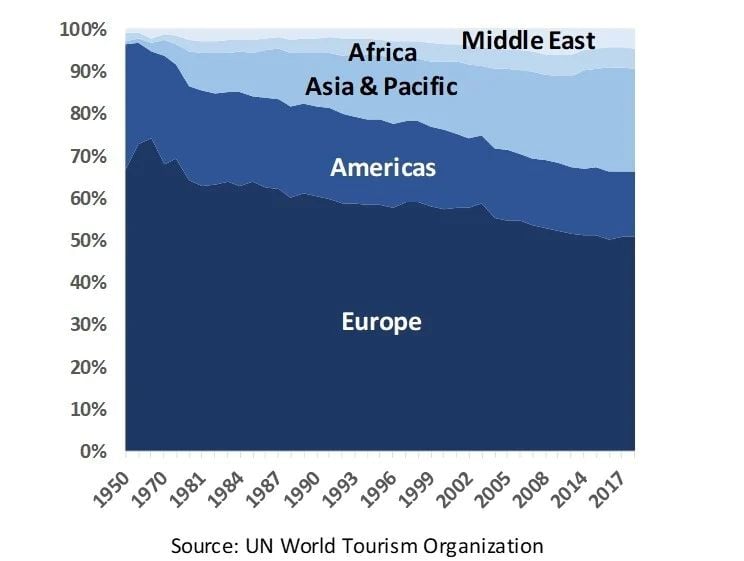Comparing Switzerland to other countries has seen its popularity as a holiday destination steadily decline. This raises questions about factors that influence international tourism flows. This article examines how demographic changes, notably the ageing of populations, can influence destination rankings. It also looks at the implications of these trends for Swiss tourism.
Switzerland’s Tourism: a 70-year decline in global popularity
The number of international trips has steadily increased in recent decades. In 1950, 25 million trips were made internationally. This number has increased to 1.4 Billion by 2018, the year of the COVID-19 pandemic. Tourism has become a major part of the economy as a result of this growth. In Switzerland for instance, travel and tourism contributed to 12.5% of employment and 9.2% of the GDP in 2019. The trend has been moving away from Europe. Switzerland in particular.
Switzerland has fallen from 5th to 35th place in the UNWTO barometer (UNWTO).
Tourism has a huge impact on economies. The Americas and Europe, for example, have lost ground. Figure 1 shows that fewer travelers are choosing to travel abroad, and more are looking towards Asia and the Pacific.
The Role of Demographics in the Past
Destination choices depend on many factors. Income plays an obvious role, as transportation and accommodation costs can be sizable, especially in certain countries. Scholars have been looking for key decision factors for decades and have consistently found that the cost of living in the destination country and exchange rates were two other important economic factors, perhaps without much surprise. The role of historical and natural sites, of temperature, sunshine as well as snowfalls at destination has also been established. Lastly, geographical, cultural and historical proximity, domestic or international conflicts, migration and political stability undoubtedly play an important role.
Travel decisions also depend on non-economic characteristics of the person traveling. For instance, there is evidence that people go abroad less often as they get older. Health typically deteriorates with age – an important aspect to take into consideration before embarking on long-distance trips!
One related factor which hasn’t been investigated much is the ageing population. For instance, one adult out of five was older than 65 in Japan in 2000. In 2020, it was one adult out of three. As populations age, does that mean that there would be less international travel if all other factors were held constant?
The answer is no. The analysis of data shows that it is quite the opposite. The ageing phenomenon is driven mostly by the increases in life expectancy, and to a smaller extent, by the drop in fertility. Living longer is, to a large extent, a by-product of medical progress that allows us to live in better health for longer. There might be an increase of the elderly in society, but this is due to better medical knowledge, meaning that people live longer and in better health, thus enabling more people to travel abroad.
The Role of Demographics in the Future
The United Nations has made projections on future fertility, mortality and migration rates, which allow researchers to estimate the expected number of old people in society. The OECD also makes projections of future economic growth. Based on these projections and the past effect of the ageing population on international travel, one can make projections of future travel between any pair of countries, ignoring all other factors that influence travel decisions. One can thus simulate future worldwide rankings simply based on changing demographics and income.
The following table compares the projections for Sweden and Switzerland, two European countries of similar ranking in 2025:
Simulations predict a different path for the two countries. On average, international arrivals in Sweden would grow by 2.2% ever year, while they would grow by 3.2% in Switzerland. Switzerland could thus maintain its worldwide position and stop the decline that has taken place since 1950. The decline is slated to, on the other hand, continue in Sweden.
Why is There Such a Difference?
The primary reason for the difference in outcomes is that the two countries attract visitors from vastly different countries. For example, twice as many people in the U.S. traveled to Switzerland (about 1 million) compared to Sweden (about 0.5 million) in 2018 just before the COVID-19 crisis. In contrast, many more travelers from Denmark visited Sweden (2.3 million) compared to Switzerland (57,000). Yet, demographic trends suggest patterns will change: Denmark’s population is expected to remain stable at around 6 million, while the U.S. population, driven by higher fertility rates, is projected to grow from 350 million to 400 million by 2070. This means that the market for international travel to Sweden is likely to grow at a slower rate than the market for international travel to Switzerland.
Implications For National Tourism Management
First of all, there are many factors and thus policy actions that can be taken to influence the attractiveness of a country to international travelers. What we learn from the simulation exercise is that demographic trends in themselves will also play a role. Relative to other European countries, these trends should help Switzerland maintain its standing, without any particular policy efforts.
Secondly, tourism operators or policy makers who want to increase international arrivals into a country can also use demographic information to define their marketing targets. As there are more international departures from countries where people live longer (and thus are healthier on average), one could focus marketing resources on countries where life expectancy is higher and projected to increase faster, assuming that all other factors influencing travel decisions are the same.
While Switzerland has seen its position as a tourist destination gradually slip since the middle of the 20th century, our simulation indicates that the downtrend is expected to level off in the coming years. Population growth in its key markets, notably in the United States, is likely to continue to bolster Swiss tourism in the near future. Shifting trends, including the ageing population and the increasing popularity of Asia-Pacific, are not predicted to cause a further decline for the Swiss tourism industry.
Further Reading
We invite you to access the full simulation here The following are some examples of how to use download the PDF.
Please consult the various publications for more information on travel worldwide. UN World Tourism Organization.
Visit the for further information about the role of simulations and demographics. “Long-run Economic and Demographic Influences on International Tourism” project.





